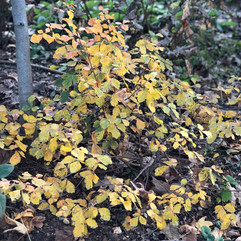All about arid.

Dry areas definitely do not have to be dull. These phenomenal natives thrive in dry areas. They are easy to grow, widely available and add all sorts of fun to your garden.
It is important to note though, these plants must be watered regularly after planting until they are well established. Their affinity for dry areas and their ability to tolerate it only kicks in after they have gotten a good, healthy start. I try to regularly water newly planted perennials for a full year and shrubs for two and when I don't, things usually don't go well.
Ground cover:

Pussytoes (Antennaria plantaginifolia) grows in the most forsaken of locations. Dry soils in full sun are no problem. These also spread into a carpet once established. They bloom with small white flowers in spring on short 5 inch stems. This is not a plant to grow for flowers though. Its' strength is developing a ground cover in challenging areas. Ours is growing in clay fill. This also is a plant that sleeps the first year, creeps the second and leaps the third. While at one time it was harder to find, native plant nurseries now regularly carry it.
Perennial Flowers:

Eastern bee balm (Monarda bradburiana) grows well in drier soils in sun to part shade. It blooms a tad bit earlier than other bee balms. You may know that many bee balms get powdery mildew and you can see spots of it in this photo if you look at the leaves. I have never been bothered by this and cut the foliage back if it gets unsightly. To minimize the chances of this, give the plant good air circulation meaning give it ample space so it is not crowded next to other plants. To me, these fascinating flowers more than make up for any mildew but not everyone feels that way. If you are in the latter camp, check out blue false indigo below. It has none of those issues!

Blue false indigo (Baptisia australis) is super easy to grow, looks spectacular in bloom and the foliage lasts the summer. The seed pods in fall are also pretty interesting -- like nature's rattle. This plant takes a while to get established if you start with a small size. It also grows by a long tap root so once you plant it, you will likely not be able to move it successfully. Choose a full sun location and plan on it's mature size so you won't be tempted to try to move it.

Coneflower (Echinacea purpurea) is almost the de facto symbolic native plant though I am told it is not technically native to Maryland. These grow best in drier soils and full sun though will also do quite well in dappled shade. After the petals fall, the seed heads will last all winter feeding birds and adding winter interest to your garden.


Monarch's Delight (Asclepias tuberosa) with its bright orange summer flowers thrives in drier soils. Yes, this is often called "butterfly weed" but people are not generally interested in planting weeds so there is an effort to rebrand the plant and I have jumped on the rebrand bandwagon! This grows best in full sun.

Mountain mint thrives in sunny dry spots. A group of these will attract a panoply of pollinators. The flowers are not terribly distinctive but once established, a clump reads as a minty green in the garden which contrasts really nicely with more common greens. Leave the stems up and add winter interest.

Penstemon 'Husker Red' (Penstemon digitalis 'Husker Red'), a perennial flower, blooms in June, Its' a great perennial flower though because after the blooms fade, the seed heads remain upright and last through the summer. This grows in full sun and dry soils.
Grasses:

Little Blue Stem (Schizachyrium scoparium) grass has the most wonderful color variation. It grows best in full sun and tops out at 2 to 4 feet. It will add graceful motion to your garden as it catches the breeze.
Shrubs:
Fragrant sumac 'gro-low' (Rhus aromatica 'Gro Low') is a small wide shrub that thrives in dry sunny areas. Its attributes are subtle. In spring, small yellow flowers form on female plants. Male plants also produce catkins later in summer. Some plants have both traits as ours does. I am not aware of a way to determine whether a plant has both before purchasing but even if the shrub had just flowers or catkins, it would still be a good plant. This sumac shrub also has strong color in fall.
It grows to about 3 feet high and up to 8 feet wide. It can grow in sun to part shade. Fragrant sumac does spread by suckering and if you let it go, it can grow into a low thicket. We just have one plant and prune out any suckers to maintain a nice oval shrub about 3 feet high and wide.
I hope these ideas help you with those confounding drier spots. If you need ideas for moist soils, check out this post from a couple of weeks ago. Dry, moist, in between, there is definitely a native plant for your situation!



















תגובות